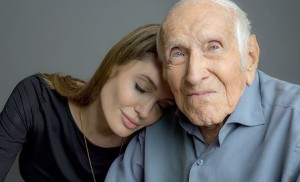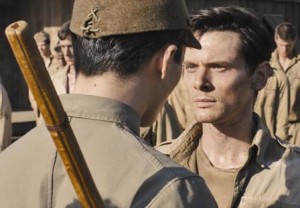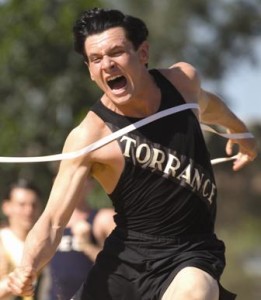Unbroken movie: hope, despair, redemption
By Rusty Wright
When Louie Zamperini boarded a World War II bomber in late May, 1943, unforeseen dangers awaited the Olympic runner and war hero. He later said he’d prefer suicide to repeating his castaway and POW ordeals.
His inspiring story – told in the bestselling book, Unbroken (Laura Hillenbrand, 2010), and now in a film (by Angelina Jolie, opening Christmas Day) – enthralls.
Zamperini, who died last July at age 97, became close friends with director and co-producer Jolie, who earlier emphasized her “huge responsibility to get [the film] right because I love him so much and because he’s helped me so much in my life.”
The movie adroitly captures part of Louie’s fascinating journey from victim to victor – and eventually – to forgiver.
Run like mad
As author Hillenbrand notes, during his youth, chronic thievery gave Louie running experience. He became a track star, competing in the 1936 Berlin Olympics. A favorite Berlin souvenir was a “Do Not Disturb” sign, swiped from sprinter Jesse Owens.
On a WW II rescue mission, engine problems crashed his plane into the Pacific, stranding him on a rubber raft with two other survivors.
Adrift
Over 47 days, they drifted 2,000 miles amid blistering sun, parched throats, empty stomachs, and circling sharks. When a Japanese bomber strafed them, the men scrambled overboard to hide from bullets, only to fight off sharks. One airman perished at sea.
Louie – not a religious person – prayed that if God would save him, he would follow and serve Him for life. After one such prayer, rain quenched their thirst. After another came a Japanese boat, and POW hell.
POW hell
Japanese doctors used Louie for medical experiments. Sadistic guards stole rations and beat prisoners. One especially despised guard, nicknamed the Bird, made Louie his special target of abuse.
The War Department declared Louie dead. At war’s end, a journalist interviewing liberated POWs remarked, “Zamperini’s dead.” The emaciated Louie had to convince the writer he was the famous athlete. “Zamperini comes back from dead” read the Los Angeles Times headline.
Bird-hunting nightmares
The film touches only briefly on Louie’s postwar years. Hillenbrand fills in “the rest of the story.”
Re-entry brought: Joyous family reunion. Marriage. Post Traumatic Stress Disorder, rage, alcohol abuse. Nightmares involving the Bird, about whose murder he obsessed.
Once, Louie dreamt he was strangling the Bird. He awoke to find himself strangling his screaming, pregnant wife, Cynthia. She eventually moved out.
But a 1949 Billy Graham outreach in Los Angeles inspired her. A reluctant Louie joined her at a subsequent Graham meeting.
Graham spoke about a woman caught in adultery and slated for death by stoning. Jesus invited any accuser who reckoned himself sinless to cast the first stone. Everyone departed. “I do not condemn you, either,” Jesus told the woman. “Go. From now on sin no more.”
Louie wanted nothing of personal faith and walked out. However, he returned the next evening – persistent wife! – but began to exit again during Graham’s invitation to faith.
New Life
Suddenly Louie recalled his promise on the raft, If you will save me, I will serve you forever. He turned to walk toward Graham, and toward a new life of faith.
The next day, he began voraciously reading the Bible, discovering inner peace and confidence in divine love that he believed had preserved him.
His marriage was restored. He told his story nationwide. He returned to Japan, not to murder the Bird and his captors but to offer forgiveness.
The Bird refused to meet with him, so Louie wrote him, saying in part, “The post-war nightmares caused my life to crumble, but thanks to a confrontation with God … I committed my life to Christ. Love replaced the hate I had for you. Christ said, ‘Forgive your enemies and pray for them.’ … I also forgave you and now would hope that you would also become a Christian.”
Delinquent, track star, war hero, castaway, prisoner, troubled veteran, redeemed peacemaker. This movie pays homage to Louie’s incredible story. Go, and be inspired.
Rated PG-13 (USA) “for war violence including intense sequences of brutality, and for brief language.”
www.UnbrokenFilm.com International release dates
Rusty Wright is an author and lecturer who has spoken on six continents. He holds Bachelor of Science (psychology) and Master of Theology degrees from Duke and Oxford universities, respectively. www.RustyWright.com
Copyright © 2014 Rusty Wright
# # #
Editors: Note pictures below. More images – and higher resolution versions of these images – are here, here, and here.
These images all are Copyright © 2014 Universal Studios. Please include credit and copyright notice when using them.

Angelina Jolie and the late Louie Zamperini
Photo: Universal Pictures
Copyright: © 2014 Universal Studios. ALL RIGHTS RESERVED.

